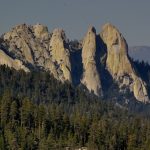INTRODUCTION
When Lewis and Clark explored the Columbia River in 1805 an estimated 16 million salmon inhabited the river. Today approximately 300 000 salmon migrate down and up the headwaters of the Columbia and its tributaries to feed and spawn. Many rivers along the North American west coast have seen a similar decline in salmon stocks over the last hundred years. There is speculation that this decrease in population is partially due to the construction of hydropower dams.
People, whales, dolphins, seals, sea lions, bears, snakes and birds all feed on salmon. Coastal economies, people’s’ jobs and the life and culture of Indigenous persons rely on healthy salmon stocks. Hydropower dams provide a valuable service to businesses and growing communities in the western world by creating a relatively clean source of renewable energy. There is a need for balance and cooperation between these two industries but the debate over direct effects of dams on salmon has prevented reaching of a common understanding.
Pacific salmon face many natural and anthropogenic threats to their survival throughout their life cycle. Predation, climate change, pollution, logging projects, habitat loss and overfishing all have an impact on salmon numbers. This paper addresses the knowledge gap concerning the influence of hydropower dams on pacific salmon stocks; It contains a history of previous research conducted in this area, outlines current knowledge and discusses previously identified effects of hydropower dams on Pacific salmon along the North American West Coast. It also describes human efforts to manage pacific salmon populations and ongoing problems with these efforts.
HISTORY OF THE ISSUE AND CURRENT KNOWLEDGE
When rivers along the West Coast started to be developed there was little consideration given to salmon populations (Waples et al. 87). There are studies that find effects of dams on downstream salmon migration to be negligible while other studies have found a strong correlation between dam installations and the mortality rates of salmon migrating downstream (Waples et al. 87; Gross 1).
The conflict between dams and salmon stocks is caused by a high demand for clean energy as North American west coast communities continue to expand in size and search for alternatives to unsustainable energy production. Before writing this paper I viewed hydropower installations as a preferable source of clean energy with limited negative consequences. Through my investigation I have found that there is a large body of evidence relating dams to problems with salmon stocks. Dams are built with energy production and economic expansion as their primary concern and this imbalance creates problems in dammed river ecosystems, salmon populations and First Nations communities.
Salmon hatch in the headwaters of their home river and swim downstream. They migrate using water currents and their sense of smell, feeding on insects and growing in size until they reach the pacific ocean. In order to hatch successfully salmon require cool, fast, oxygen-saturated water that is free of excess dirt and silt (Booth 195; Vancouver Aquarium 1).
Decreases in salmon stocks have resulted in a decrease of profit and employment in the salmon fishing industry. Fishing communities that once boomed from salmon abundance are now small and quiet and people who work in these towns today struggle to make a profit (Burne 42).
HAZARDS OF DAMS TO SALMON
Initially I guessed that any problems for salmon created by dams would be compensated for through the construction of hatcheries and fish ladders. I did not know that fish ladders have to be well constructed and strategically placed or else salmon will be drawn away by the splashing of water released from the dam (Muir and Williams 21). Salmon also face problems with dams when swimming downstream; for example, Many salmon are sucked into turbines and killed instantly (Booth 195). Some hydropower companies have adapted to this problem by creating surface passages. Unfortunately, these passages leave salmon vulnerable to predation because of their exposure and limited opportunities for escape (Rechinsky 6885).
Water pools before dams tend to be slower; this forces young salmon to exert energy as they migrate downstream instead of floating with the current. The calm reservoirs of water stored behind dams leave salmonids confused about their direction of travel, meaning it takes them longer to reach the ocean (Waples et al. 90). The lack of current in these pools also makes for less disturbance on the surface of the water and this leaves salmon more visible to predators (Waples et al. 90; Booth 196). Young salmon often encounter other species of fish in reservoirs as well. Reservoirs are conducive to the expansion of other aquatic species and especially non-native fish in some cases (Waples et al. 90). In the Columbia and Snake rivers different species of bass consume up to 35% of young salmon in some populations (Waples et al. 90). Dam construction encourages agriculture because of the water used for irrigation as well; just one third of water taken from streams and lakes in the Pacific Northwest is ever returned (Waples et al. 91). The returned water usually contains less oxygen, higher temperature, sediment and volatile pesticides and fertilizers (Waples et al. 91). These added variables have negative effects on salmon growth, disease immunity and overall survival (Waples et al. 91).
Changes in water temperatures also affect the metabolism of salmon predators and one study found that juvenile salmon predation is 30% higher in warmer waters (Waples et al. 91). Studies indicate that the stress and oxygen deprivation that salmon endure while travelling through dams has an effect on their health and longevity (Burnett et al. 588). Salmon swim in bursts through dam passages that contain low oxygen levels and combined with the salmon’s increased physical exertion a problem of oxygen deprivation known as anaerobiosis is created (Burnett et al. 588). One study found that anaerobiosis in salmon had a direct effect on their mortality and lifespan (Burnett et al. 590).
Salmon are also physically injured by the rapid decompression of water pressure when they pass through the dams, a phenomenon known as barotrauma (Trumbo et al. 960).
The reduced number of spawning streams caused by dam installation results in less spawning grounds for salmon (Waples et al. 88). If female salmon cannot find suitable gravel to lay their eggs they will use their tails to uncover and dislodge eggs laid by other salmon and lay their eggs in place, meaning eggs laid by the other salmon will not hatch (Vancouver Aquarium 1).
RISKS OF DAMS TO SALMON
In the Columbia River dams have reduced salmon habitat to 45% of what it was before dams were installed (Waples et al. 88). The blocking and storage of water by dams creates lower water levels which in turn creates higher temperatures meaning less efficient growth for salmon (Waples et al. 89). There is even speculation that changes to water levels, water temperatures and river bank vegetation caused by dams could mean evolutionary changes to salmon (Waples et al. 94).
There are also risks associated with dam expiration. According to the Massachusetts Institute of Technology the average lifespan of a dam is half a century and in another five years from now 85% of dams in the United States will be 50 years old and in need of repair (Massachusetts Institute of Technology 1). The MIT website goes on to say that fixing only the structures in most urgent need of repair will cost 10.1 billion dollars over the next 12 years and the site adds that in many cases dams are demolished if reparations are not cost efficient (Massachusetts Institute of Technology 1). This destruction of dams has the potential to disturb the surrounding ecosystem and this implies yet another risk to salmon stocks (Massachusetts Institute of Technology 1).
EFFORTS TO MANAGE SALMON POPULATIONS
Policies around fishing did not start until mid-late 20th century. Hatcheries have since been introduced in an effort to restore salmon to abundance and to learn more about them but even these practices are not without complications. Wild salmon are naturally more aggressive and there is a concern that cross breeding between wild and hatchery salmon populations could weaken this characteristic.
Hatchery salmon are often hand-fed in their tanks and when the shadow of the feeding hand passes over the tank, salmonids rise to the surface in order to reach the food first. This learned behaviour works well in captivity, however, hatchery salmon take this behaviour with them when they migrate to the ocean and shadows of birds passing over salmon causes them to rise to the surface and become susceptible to predation.
PERSONAL EXPERIENCE AND LOCAL RELEVANCE
I visited the Hell’s Canyon dam installation on the Snake river in Idaho last summer and saw the dramatic effect that large scale dam installations have on surrounding ecosystems. There were no visible fish passages and in the reservoir above the dam and I saw roughly 20 carp swimming at the surface of the water. I rafted and fished the waters below the dam and noticed that bass have replaced salmon populations almost entirely. I caught a few bass each day as well as one sturgeon but on the whole length of our trip I never saw a single salmon. The absence of salmon now stands out to me as a first hand exposure to the reality of habitat loss and the incident made me realize the impact that anthropogenic developments have on previously undisturbed ecosystems.
Hydropower is the third biggest energy producer to British Columbia after natural gas and crude oil. With the continuous building of dams along waterways in British Columbia there is an increasing concern for local salmon populations and their migration routes. There are alternatives in small hydropower installations that do not interfere with salmon migration but these projects can only provide a fraction of the power required for the lower mainland. BC has hatcheries that produce salmon, the Capilano River Hatchery in North Vancouver for example, which uses automated food dispensers and hand feeding to feed their juvenile salmon. Over the course of my research I discovered that trained feeders at the Capilano hatchery keep a distance from the tanks so as not to cast stimulus-provoking shadows over the fish.
CONCLUSION
Hazards and risks to pacific salmon are numerous and should all be considered when looking at specific influences to the well-being of these animals. Hydropower installations are beneficial to western communities and economies but come with consequences to the ecosystems where they are established. Awareness around the impacts of hydropower dams to salmon is imperative to keeping salmon populations abundant and salmon habitats unblemished. A higher number of publicly available studies with definitive conclusions regarding the risks and hazards of dams to salmon are required in order to make the connection between hydropower dams and salmon stocks unavoidably certain in the eyes of hydropower energy companies. A more environmentally conscious approach to dam construction and demolition by these companies in view of this evidence can mitigate the negative effects of dams to salmon populations.






fortnite free skin
July 6, 2021 — 1:16 pm
So if you want to get this hacking tool,now just join this website and easily to download.
Slope 2
December 6, 2022 — 3:05 am
There are several hazards and dangers that pacific salmon face, and they should all be taken into account when examining particular affects on their wellbeing.
uno online
June 7, 2023 — 12:42 am
Your writing is really informative, especially because it’s so meaningful and updated. Thanks for sharing this wonderful post!
bacicucina
October 12, 2023 — 2:39 am
Picture a world where jumping into paintings opens up entire realms of wonder and challenges. super mario 64 is the portal to this enchanting universe.
super edan
November 27, 2023 — 7:48 pm
The creators of the Watermelon Game prioritize inclusivity, making it accessible to a wide audience. The game is designed to be playable on various devices, from smartphones to tablets and computers.
Armanunderpin
December 27, 2023 — 4:13 am
Your writing style is like a friendly guide through the scientific wilderness, making complex concepts accessible to a non-expert like me. The way you navigated through the impacts on salmon populations, diving into the nuances of the Adipose Complex, was both enlightening and engaging.
konopelski
January 14, 2024 — 8:55 pm
We can delve into the excitement of escaping the pursuers, weaving through traffic, and outsmarting your opponents in getaway shootout
Jenelle Dennell
March 26, 2024 — 1:04 am
Writing service review offers insights into various platforms. Is papersowl reliable? Papersowl excels in writing content creation, providing high-quality essays tailored to clients’ needs, ensuring academic standards are met effectively and efficiently.
prodentim
March 26, 2024 — 9:30 pm
??
Wayna Wahunsenacawh
April 5, 2024 — 11:46 am
As an expert in academic essay help, I can’t vouch for specific services, but you should thoroughly research any platform before using it. Look for reviews, check their policies on plagiarism, and ensure they prioritize your academic integrity is papercoach safe. Always exercise caution when using online services for academic support.
Beetv Apk
April 20, 2024 — 4:09 am
BEETV APK is a popular streaming app designed for Android devices. It gives users access to a huge library of movies and TV shows, without subscription or payment. BEETV is known for its user interface that makes it easy to find content and offers a host of features to enhance your streaming experience.
Blink Streamz Apk
April 20, 2024 — 4:10 am
Blink Streamz APK is an entertainment app for your Android device. Download the latest version for free today and enjoy uninterrupted live television.
OpenIV
April 20, 2024 — 4:12 am
OpenIV 4.1 is one of the best modding tools for PC versions like GTA 5, GTA 4, Episodes from Liberty City (EFLC) and Max Payne 3. The latest version of the app also supports Red Dead Redemption 2. The tool allows users to view and edit game files. This is only limited to the PC version and not allowed in the online version of the game.
The development of this tool started in 2008. Since then, the process has changed a lot and many teams have developed. The developers of OpenIV have worked hard since its first release to make it the most reliable modding tool for Grand Theft Auto 5/4, EFLC, Max Payne 3, Read Dead Redemption 2, etc.
Dofu Sports Apk
April 20, 2024 — 4:15 am
Dofu Sports is a European football and basketball app for Android. You can watch all sports games online. This is a popular app for tracking many leagues in the US. This app helps you to watch football, basketball, hockey and cricket matches for free. You can earn real money by playing games or betting according to the rules of the program using the Dufo Sports program. However, the program can be used in the simplest way. There are no problems using the app.
Dofu Sports APK is an online platform where you can watch your favorite movies, football and basketball events. In addition, the application is free to download. You can download and use this program on your mobile phone. You can also install the application on the Android operating system. The app is currently available for Android phones. The program is very popular in the US. Many users use this app to watch football and basketball. The app provides you with a good interface. There is LiveTV SX. Inside, users can get the best movies at their fingertips with the app.